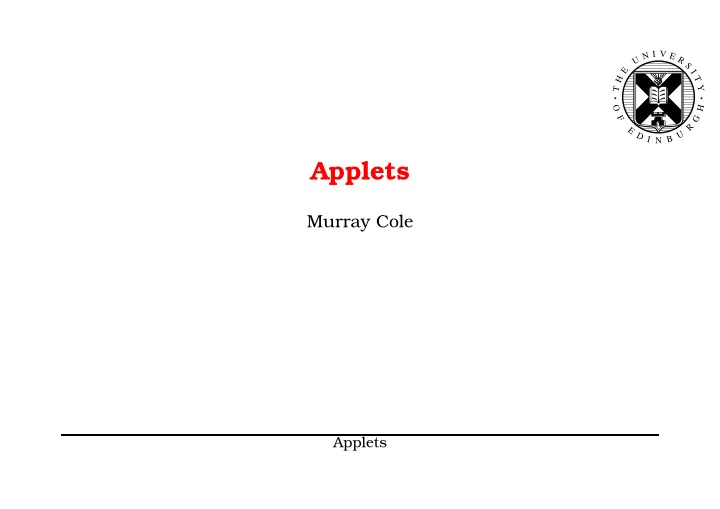

I V N E U R S E I H T Y T O H F G R E U D I B N Applets Murray Cole Applets
� � � 1 Portability and Security JVM and bytecode make portability “easy” facilitates sharing of programs, which can be good and bad can we make sharing safer? Applets
� � 2 Applets A sub-class of Java programs which run from within web pages (byte code is provided by the web site (server) but run in your browser (client)) are restricted in what they can do (no local file access, no networking (eg e-mail), no “messing with the local system”). This is called sandboxing. The restrictions are enforced by the JVM through its security manager. Applets
Slide 2 on board illustration of client server nature of web activity, download byte code & run on client, not server. Think of some little graphical app. Also reduced load on server.
� � � � 3 java.lang.Object ( equals , getClass , toString , . . . ) java.awt.Component ( add X Listener , repaint . . . ) java.awt.Container ( add , remove , paint , setLayout , . . . ) java.awt.Panel ( Panel , addNotify ) java.applet.Applet ( init , stop , start , destroy . . . ) Applets
� � 4 Class java.applet.Applet The applet interface (in the Java sense, not the GUI sense) specifies a number of new methods, including void init() , invoked when the applet is first downloaded void start() , invoked whenever the applet is started (or re-started) Since it extends Component it also has a paint method. Applets
5 public class Clicker extends Applet { private int clicks; // Click counter public void paint(Graphics g) { g.setColor(Color.white); g.fillRect(0, 0, 400, 400); g.setColor(Color.black); g.setFont( new Font("TimesRoman", Font.BOLD, 64)); g.drawString("Clicks: " + clicks, 60, 240); } public void init() { addMouseListener( new MouseAdapter() { public void mouseClicked(MouseEvent e) { clicks++; repaint(); } }); }} Applets
6 The HTML file HyperText Markup Language (HTML) describes web pages. <html> <head> <title>The Clicker Applet</title> </head> <body> <h1>The Clicker Applet</h1> <applet code="Clicker.class" width="400" height="400"> </applet> <hr> </body> </html> Applets
7 A Really Useful Applet Applets
� � � 8 Design Issues (1) The game itself board and current moves choosing a computer move winning Applets
9 public class OXO extends Applet { int movesmade; boolean player[] = new boolean [9]; boolean computer[] = new boolean [9]; boolean MoveOK ( int m) { return !(computer[m] || player[m]); } void computerMove () { int m; m = ( int ) (Math.random()*9); while (!MoveOK(m)) { m = ( int ) (Math.random()*9); } movesmade++; computer[m] = true; } Applets
10 // Check all the possible ways of winning boolean won ( boolean []moves) { return (moves[0] && moves[1] && moves[2]) || (moves[3] && moves[4] && moves[5]) || (moves[6] && moves[7] && moves[8]) || (moves[0] && moves[3] && moves[6]) || (moves[1] && moves[4] && moves[7]) || (moves[2] && moves[5] && moves[8]) || (moves[0] && moves[4] && moves[8]) || (moves[2] && moves[4] && moves[6]); } Applets
11 public void start() { movesmade = 0; for ( int i=0; i<9; i++) { computer[i] = false; player[i] = false; } Applets
12 this .addMouseListener( new MouseAdapter() { public void mouseReleased(MouseEvent e) { int x = e.getX(); int y = e.getY(); Dimension d = getSize(); int r = (y * 3) / d.height; int c = (x * 3) / d.width; if (MoveOK(r*3 + c) && !won(player) && !won(computer)) player[r*3+c] = true; // Make the move movesmade++; repaint(); if (!won(player) && (movesmade < 9)) { computerMove(); repaint(); } } }}); Applets
� � � 13 Design Issues (2) Representing the game on screen capturing the player’s move drawing the grid drawing moves Applets
14 public void paint(Graphics g) { Dimension d = getSize(); setBackground(Color.white); g.setColor(Color.black); int xoff = d.width / 3; int yoff = d.height / 3; g.fillRect(xoff-2, 0, 4, d.height); g.fillRect(2*xoff-2, 0, 4, d.height); g.fillRect(0, yoff-2, d.width, 4); g.fillRect(0, 2*yoff-2, d.width, 4); for ( int r = 0 ; r < 3 ; r++) for ( int c = 0 ; c < 3 ; c++) if (player[r*3+c]) drawX(g, r, c, d.width/3, d.height/3); else if (computer[r*3+c]) drawO(g, r, c, d.width/3, d.height/3); } Applets
15 void drawO (Graphics g, int r, int c, int boxw, int boxh) { g.setColor(Color.red); g.fillOval(c*boxw + boxw/4, r*boxh + boxh/4, boxw/2, boxh/2); g.setColor(Color.white); g.fillOval(c*boxw + boxw/4 + boxw/10, r*boxh + boxh/4 + boxw/10, boxw/2 - boxw/5, boxh/2 - boxw/5); } Applets
16 void drawX (Graphics g, int r, int c, int boxw, int boxh) { Polygon p1 = new Polygon(); Polygon p2 = new Polygon(); // Top left to bottom right swish p1.addPoint(c*boxw + boxw/4, r*boxh + boxh/4); p1.addPoint(c*boxw + boxw/4, r*boxh + boxh/4 + boxw/5); p1.addPoint((c+1)*boxw - boxw/4, (r+1)*boxh - boxh/4); p1.addPoint((c+1)*boxw - boxw/4, (r+1)*boxh - boxh/4 - boxw/5); // Similarly bottom left to top right swish g.setColor(Color.blue); g.fillPolygon(p1); g.fillPolygon(p2); } Applets
Recommend
More recommend